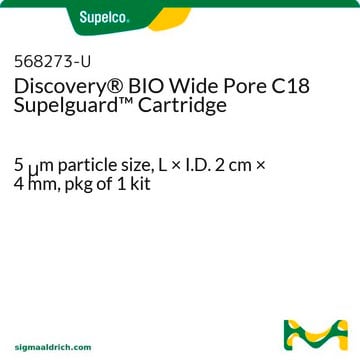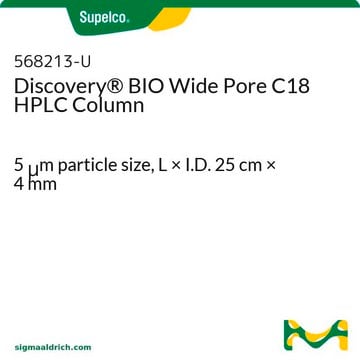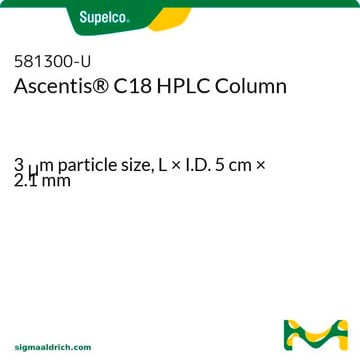Reverse Phase Column Rehydration Method:
1. The column should ideally not contain any buffer. If it does, thoroughly flush the column with water to remove the buffer.
2. Flush the column with 100% acetonitrile, starting at a flow rate of 0.3-0.5 ml/minute. Slowly increase the flow rate to 1 ml/minute, flushing for approximately 30 minutes, as long as the pressure does not excessively increase.
3. Equilibrate the column with the mobile phase specified on the Certificate of Analysis (CofA) of the column, and run a test mix similar to what was used to test the column.
4. If the performance is unsatisfactory, repeat the method, increasing the flushing with acetonitrile for one hour.
5. Repeat the test. If the performance is still not as expected, the column may have degraded.
Kluczowe dokumenty
568223-U
Discovery® BIO Wide Pore C18 (5 µm) HPLC Columns
L × I.D. 25 cm × 4.6 mm
Synonim(y):
Kolumna C18 HPLC o szerokich porach
Wybierz wielkość
4690,00 zł
Wybierz wielkość
About This Item
4690,00 zł
Polecane produkty
Nazwa produktu
Discovery® BIO Wide Pore C18 HPLC Column, 5 μm particle size, L × I.D. 25 cm × 4.6 mm
Materiały
stainless steel column
Poziom jakości
agency
suitable for USP L1
linia produktu
Discovery®
Właściwości
endcapped
producent / nazwa handlowa
Discovery®
opakowanie
1 ea of
zakres etykietowania
9.2% Carbon loading
Parametry
0-70 °C temperature
400 bar pressure (5801 psi)
metody
HPLC: suitable
LC/MS: suitable
dł. × śr. wewn.
25 cm × 4.6 mm
powierzchnia
100 m2/g
pokrycie powierzchni
3.6 μmol/m2
Matryca
silica particle platform
fully porous particle
grupa aktywna macierzy
C18 (octadecyl) phase
wielkość cząstki
5 μm
wielkość porów
300 Å
pH robocze
2-8
metoda separacji
reversed phase
Szukasz podobnych produktów? Odwiedź Przewodnik dotyczący porównywania produktów
Opis ogólny
Zastosowanie
- Porównanie wydajności kinetycznej powierzchniowo porowatych, w pełni porowatych i monolitycznych kolumn z fazą odwróconą za pomocą gradientowych wykresów kinetycznych do separacji biofarmaceutyków białkowych...: Niniejsze badanie zapewnia szczegółowe porównanie wydajności kinetycznej różnych typów kolumn HPLC z odwróconą fazą, w tym kolumny 891 BIO Wide Pore C18 HPLC. Badania podkreślają jej skuteczność i rozdzielczość w rozdzielaniu złożonych biofarmaceutyków białkowych, co czyni ją cennym narzędziem dla chemików analitycznych w analizie biofarmaceutycznej (Jaag et al., 2022).
- Analiza RP-LC x RP-LC trawienia tryptycznego przy użyciu kombinacji całkowicie porowatych i częściowo porowatych faz stacjonarnych ..: W artykule zbadano zastosowanie chromatografii cieczowej w odwróconym układzie faz (RP-LC) z całkowicie porowatymi i częściowo porowatymi fazami stacjonarnymi, w tym kolumny BIO Wide Pore C18 HPLC, do analizy trawienia tryptycznego. Wyniki wskazują na jej solidność i wysoką rozdzielczość w zastosowaniach proteomicznych, umożliwiając precyzyjne mapowanie peptydów i charakterystykę białek (Mondello et al., 2010).
Informacje prawne
Zastosowanie
kartridż do prekolumny
Wybierz jedną z najnowszych wersji:
Masz już ten produkt?
Dokumenty związane z niedawno zakupionymi produktami zostały zamieszczone w Bibliotece dokumentów.
Klienci oglądali również te produkty
Powiązane treści
DiscoveryBIO Wide Pore C18 products offered by Sigma-Aldrich.
Chromatograms
application for HPLC-
What is the method for rewetting a column that may have dried as a result of the end cap being loose or not being used for an extended period of time?
1 answer-
Helpful?
-
-
WHIGH SOLVENT USED FOR WASHING OF COLUMN
1 answer-
See below for a general cleaning protocol:
1. Reverse the orientation of the column
2. Flush for a few minutes, or >1 column volume, with a 20% solution in water, of the organic used in the analysis, such as methanol or acetonitrile. This is to remove any residual buffer salts.
3. Flush for approximately 30 mins, or >10 column volumes, with 100% of the organic solvent used in the analysis.
4. The column can be stored with this organic solvent until ready for use.
5. Before reusing the column, flush again, as per step 2.Helpful?
-
Active Filters
Nasz zespół naukowców ma doświadczenie we wszystkich obszarach badań, w tym w naukach przyrodniczych, materiałoznawstwie, syntezie chemicznej, chromatografii, analityce i wielu innych dziedzinach.
Skontaktuj się z zespołem ds. pomocy technicznej










